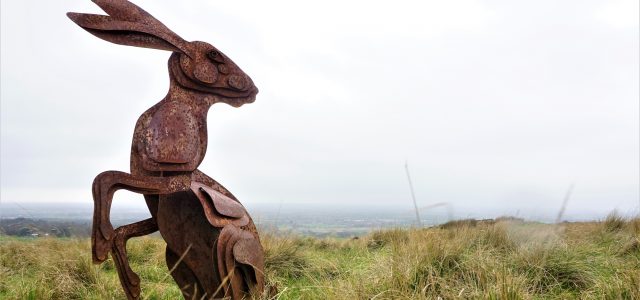
WILD COUNTRY
A 3.6m steel sculpture of a hare has been created to celebrate the wild fells and countryside of the Forest of Bowland
Dutch artist and sculptor Marjan Wouda has created an iconic piece of work that is hoped will become a central feature on Nicky Nook fell on the Wyresdale Park Estate. The 3.6m sculpture created by Lancashire-based Marjan, celebrates the hare, which has such a unique presence in the Forest of Bowland and in the story-lore of the county.
The environment in the Forest of Bowland represents a stronghold for the brown hare as numbers are steady – while nationally it has been in marked decline since the 1960s due to decreased crop diversity.
“It shows us just how precious this landscape is and how rare,” explains Marjan, whose work is spread far and wide, from New Zealand and Hong Kong to Europe, the Caribbean and America. Her work has been bought or commissioned by both private collectors and public institutions. She has exhibited across the world and her work features in public spaces in London, Greater Manchester, Newcastle-upon-Tyne and green spaces in Lancashire and Yorkshire.
It is hoped Nicky Nook will be the first of the sculpture’s slow tour of the most stunning locations in the Forest of Bowland. It is also the first piece in the outdoor gallery James Whewell, the owner of the estate, envisages: “I hope it will be the first of many,” he says.
“I am keen to attract more people from places such as Liverpool and Manchester and believe great art in this beautiful location will do just that.”
Marjan adds: “I love creating sculpture for outdoor spaces. finding absolutely the right spot for a piece is like a marriage made in heaven. I could never have dreamed of finding a space like the one James Whewell showed me when we explored potential sites on the Wyresdale Park Estate.
It was as though it had been waiting all along for the sculpture to arrive.
“I started thinking about creating a large hare sculpture many moons ago, through a combined interest in folklore and landscape. I believe we still have a deep connection with animals, undiminished by the fact that most of us live in towns and cities, and I look for iconic subjects for sculptures in folklore. Here we find stories that link us to particular places and images that continue to speak to us today.”
The hare comes up as a ‘familiar’ (an entity associated with witchcraft and often in the form of an animal – think of Harry Potter’s owl) in several Lancashire sources, from that of the Pendle Witches to a ghost story from across Morecambe Bay.
“Learning of the importance of the hare in this landscape in terms of its natural history confirmed its significance and made me start thinking how fitting it would be as a subject for a large-scale public sculpture.”
While most of Marjan’s work has been in bronze and clay, she was keen to find a way of making sculptures from sheet steel, allowing work on a much bigger scale.
“Scale is a powerful tool, when it comes to creating work for outdoor spaces – the piece needs to be robust in form, if it is to hold its own in a beautiful landscape such as this. And here in Lancashire we have the most up to date technology for the design and fabrication from sheet metal.”
The sculpture is created from a number of pre-cut curved Corten steel plates – a type of steel that will develop a stable, rust-like appearance when it is exposed to the elements. The rusty colouration does not penetrate the steel but imbues it with a hot deep-orange hue.
The plates are welded together with spaces in-between to form a robust but open structure.
“I started to develop the idea for the sculpture cutting and sticking paper shapes together, translating the design into a digital format with support from The Making Rooms in Blackburn,” explains Marjan.
“Representing a three-dimensional form in flat layers of steel was an exciting challenge. I aimed to create a dynamic form, inviting visitors to move around it taking it in from different angles. Where possible the sheet metal is curved using a tool much like a mangle to give it flow and enhance the beauty of it.”
“By having the sculpture visit various locations I am keen to explore how people will respond to finding art in their landscape. In this way I hope to start a conversation which may lead to realising a trail of permanent sculptures based on local stories. That would really put Lancashire and the Forest of Bowland on the map and get people both talking and walking!”
The hare features in the most well-known story coming out of Lancashire – the story of the Pendle Witches. One member of the group convicted of witchcraft in 1612 tells of meeting a hare on his way back from church.
Another story of a hare as a familiar was recorded at Furness across Morecambe Bay. A scraggy white hare with bloodshot eyes is seen accompanying the spectral figure of the White Dobbie. Together they roam the coastal road – the hare is heard talking while the Dobbie never speaks a word.
The publication of a small book telling the story of the White Dobbie in words and images will coincide with the launch of the sculpture. It will be the first in a series of folkloric retellings in collaboration with writer Jacqueline Harris and photographer Scott David Jackson. The artwork is in the mediums of sculpture and ink on paper creating an atmospheric setting for this haunting story.
The making of the Bowland Hare would not have been possible without the generous support of the following: Castle Fine Art Foundry, Steel Dynamics, Blackburn, James Whewell, Wyresdale Park, the Making Rooms, Blackburn and the Crafty Vintage Corporation.

